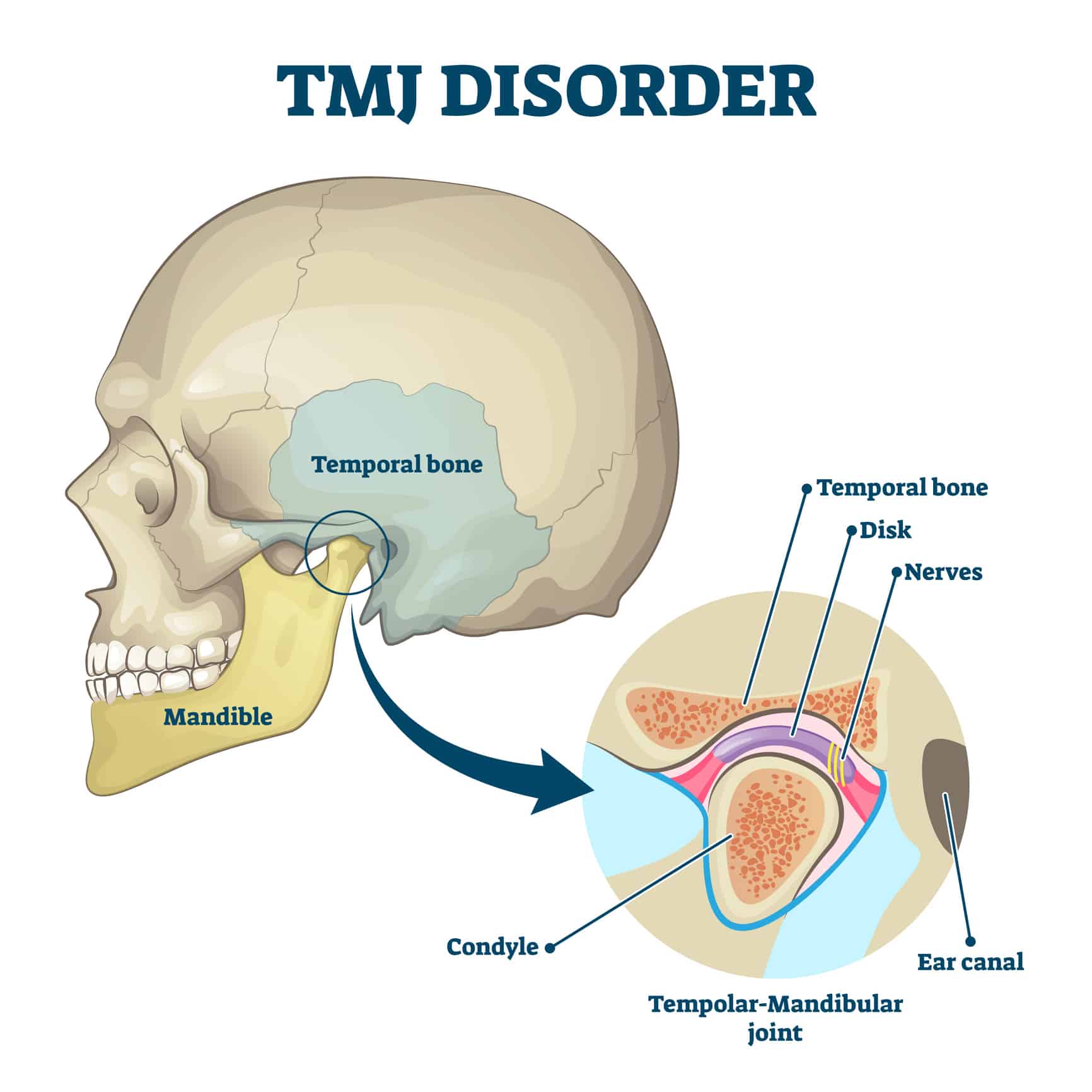TMJ Disorder – Symptoms, Causes, and Treatment Options
Temporomandibular joint disorder (TMJ disorder) refers to problems affecting the hinge joint that connects your jaw to your skull. This joint allows you to talk, chew, and yawn. When it doesn’t work properly, you may feel jaw pain, stiffness, clicking sounds, or difficulty opening and closing your mouth. TMJ disorder can disrupt daily life, from eating and speaking to sleeping and managing stress.
Many people with TMJ find relief and recover faster with chiropractic care for TMJ, which can help improve jaw alignment, reduce joint tension, and ease discomfort. Physiotherapy for TMJ provides targeted exercises and manual techniques to restore mobility, strengthen supporting muscles, and improve function. Massage therapy for TMJ also helps by releasing tight jaw and neck muscles, improving circulation, and reducing stress-related tension. Together, these treatments can ease pain, restore comfortable movement, and prevent future flare-ups.

Overview of TMJ Disorder
TMJ disorder is a common condition that affects the jaw joint and surrounding muscles. It is sometimes called TMD (temporomandibular disorders) and can vary widely in severity—from mild, short-term discomfort to chronic pain that impacts daily function.
What is TMJ Disorder?
Your temporomandibular joints are located on each side of your face, just in front of your ears. These joints act like sliding hinges, allowing smooth jaw movement. TMJ disorder occurs when these joints or their supporting muscles become irritated, inflamed, or misaligned.
- Prevalence: Research shows that TMJ disorders affect about 5–12% of the population, with women more commonly affected than men (National Institute of Dental and Craniofacial Research, 2021).
- Age: It often develops between the ages of 20–40, though anyone can experience it.
- Impact on daily life: TMJ disorder can interfere with eating, speaking, sleeping, and even working. Chronic jaw pain may also affect mood, relationships, and mental well-being.
How Does TMJ Disorder Affect Daily Life?
Living with TMJ disorder can be frustrating and exhausting. You may notice:
- Eating challenges: Chewing tough foods can trigger sharp pain or fatigue in your jaw.
- Sleep disruption: Nighttime grinding or clenching (bruxism) can worsen pain and lead to restless sleep.
- Work and focus: Constant discomfort can reduce productivity and concentration.
- Social impact: Avoiding meals with friends, feeling self-conscious about jaw sounds, or struggling with speech can affect confidence and relationships.
- Emotional well-being: Long-term pain may increase anxiety, irritability, and even depression.
Comparison with other conditions: Unlike ear infections or dental cavities, TMJ disorder pain usually worsens when you move your jaw and may be paired with jaw clicking or locking. This helps distinguish it from other head, ear, or dental conditions.
Symptoms of TMJ Disorder
The symptoms of TMJ disorder can be wide-ranging and may come and go. Some people only notice mild jaw clicking, while others develop severe pain and functional problems that affect their quality of life.
What Are the Main Symptoms of TMJ Disorder?
- Jaw pain or tenderness – often in front of the ears or along the jawline.
- Clicking, popping, or grinding sounds when opening or closing the mouth.
- Limited movement or jaw locking – difficulty fully opening or closing your mouth.
- Ear-related symptoms – ringing in the ears (tinnitus), earaches, or pressure without infection.
- Headaches and facial pain – often described as tension headaches or pressure around the temples.
- Tooth sensitivity or wear – from clenching or grinding at night.
How Severe Can Symptoms Get?
Symptoms range from mild stiffness to chronic, debilitating pain. For example:
- Some people feel only occasional discomfort when eating chewy foods.
- Others experience daily pain, jaw locking, or severe headaches that interfere with work and sleep.
Red Flags: When to Seek Medical Help
See a healthcare provider if you notice:
- Sudden jaw locking that prevents opening or closing.
- Persistent ear pain without infection.
- Severe headaches linked to jaw movement.
- Ongoing pain lasting more than a few weeks.
How TMJ Disorder Affects Daily Function
- Work: Frequent headaches or jaw discomfort may reduce productivity.
- Sports: High-impact or teeth-grinding activities can aggravate jaw pain.
- Sleep: Nighttime clenching can cause poor rest, leading to fatigue.
- Relationships: Chronic pain may cause stress, irritability, or withdrawal from social activities.
Reference:
Durham, J., Newton-John, T., & Zakrzewska, J. M. (2015). Temporomandibular disorders (TMD): an overview. British Dental Journal, 219(10), 501–505. https://doi.org/10.1038/sj.bdj.2015.902
Causes and Risk Factors for TMJ Disorder
TMJ disorder develops from a mix of physical, lifestyle, and sometimes psychological factors. It’s rarely caused by a single issue. Instead, multiple triggers can interact over time.
What Causes TMJ Disorder?
- Jaw injury or trauma – accidents, dental surgery, or sports injuries.
- Teeth grinding and clenching (bruxism) – especially at night, leading to joint stress.
- Arthritis – osteoarthritis or rheumatoid arthritis can damage joint cartilage.
- Misaligned bite (malocclusion) – uneven pressure on the jaw joints.
- Muscle overuse – chewing gum, nail biting, or holding the jaw in tense positions.
Lifestyle and Risk Factors
Certain habits and health conditions increase your risk:
- Age: More common in young and middle-aged adults.
- Gender: Women, especially during childbearing years, are at higher risk—possibly linked to hormones.
- Posture: Poor head and neck posture can strain jaw muscles.
- Occupation: Jobs requiring long hours of talking, singing, or stress may worsen symptoms.
- Stress and anxiety: Emotional tension often leads to jaw clenching or teeth grinding.
- Other health conditions: Obesity, connective tissue disorders, and pregnancy can influence TMJ symptoms.
How TMJ Disorder Differs from Other Jaw Pain
- Unlike dental decay, TMJ pain worsens with movement but may not involve tooth sensitivity.
- Unlike ear infections, TMJ pain often comes with jaw clicking or limited motion.
Reference: de Leeuw, R., & Klasser, G. D. (2018). Orofacial Pain: Guidelines for Assessment, Diagnosis, and Management (5th ed.). Chicago: Quintessence Publishing.
Diagnosis, Recovery, and Management of TMJ Disorder
Temporomandibular joint disorder (TMJ disorder) is complex and often requires a careful approach to confirm the diagnosis, set realistic recovery expectations, and build a long-term management plan. This section explains how TMJ disorder is diagnosed, what recovery may look like in mild, moderate, and severe cases, and evidence-based strategies to manage symptoms and prevent flare-ups.
Diagnosis of TMJ Disorder
TMJ disorder is diagnosed through a combination of physical examination, medical history, and sometimes imaging tests. The goal is to confirm the source of pain, rule out other conditions, and understand the underlying cause.
How Do Doctors Test for TMJ Disorder?
Your healthcare provider typically begins with a physical exam:
- Checking jaw movement while you open and close your mouth.
- Listening and feeling for clicking, popping, or grinding sounds in the joints.
- Pressing on the jaw muscles to check for tenderness or spasms.
- Measuring how wide you can open your mouth and whether it shifts to one side.
These simple tests often provide the first clues. For example, if your jaw locks or pain increases with movement, it suggests TMJ involvement rather than an ear or dental problem.
What Imaging Tests Might Be Used?
In more complex cases, imaging can help rule out other causes:
- X-rays – show bone structure and arthritis changes.
- MRI scans – assess the soft tissues, including cartilage and disc displacement.
- CT scans – provide a detailed look at bone alignment or fractures.
Most people with TMJ disorder don’t need advanced imaging, but it may be ordered if conservative treatments aren’t helping or if jaw locking is severe.
How Do Practitioners Find the Root Cause?
TMJ disorder is rarely caused by one factor. During evaluation, providers look at:
- Dental bite alignment – whether your teeth fit together properly.
- Bruxism (teeth grinding) – often linked to stress or sleep disorders.
- Posture and muscle tension – poor head/neck posture can strain the jaw.
- Lifestyle habits – chewing gum, nail biting, or clenching.
- Medical history – arthritis, connective tissue disorders, or trauma.
This process helps distinguish TMJ disorder from similar conditions like ear infections, sinusitis, or dental abscesses, which can also cause face or jaw pain but respond to very different treatments.
Recovery Timeline for TMJ Disorder
Recovery from TMJ disorder varies depending on severity, cause, and how well self-care and treatment strategies are followed. Many people experience improvement within weeks, but chronic cases may take months or require ongoing management.
How Long Does TMJ Disorder Usually Take to Heal?
- Mild cases: Often improve within 2–4 weeks with rest, stress reduction, and simple self-care.
- Moderate cases: May take 2–3 months, especially if linked to habits like clenching or poor posture that need correction.
- Severe cases: Can last 6 months or longer, particularly if arthritis, trauma, or disc displacement is involved. Some people manage symptoms long-term rather than fully “healing.”
If/Then Recovery Pathway
- If you have mild symptoms (occasional jaw clicking, mild soreness), then home care like posture correction and stress reduction may be enough.
- If you have moderate symptoms (frequent pain, headaches, limited jaw movement), then a combination of professional therapy and home exercises is usually required.
- If you have severe symptoms (locking jaw, chronic pain, significant functional impact), then medical intervention, imaging, and possibly specialist referral may be needed.
Will TMJ Disorder Come Back?
Yes, TMJ symptoms can recur, especially under stress or if habits like clenching return. Long-term outcomes depend on:
- Stress management.
- Consistent posture and ergonomics.
- Avoiding overuse of the jaw.
- Managing arthritis or other chronic conditions.
Recovery and Daily Life
- Return to work: Most people with mild or moderate cases continue working with minor adjustments. Severe cases may need temporary modifications (avoiding long speaking or strenuous chewing).
- Return to sport: Low-impact activities are usually fine. High-contact sports may increase flare-ups if jaw injury risk is high.
- Lifestyle adjustments: Many learn strategies to prevent relapse, such as using bite guards, adjusting diet, or improving workstation ergonomics.
Reference:
Wieckiewicz, M., Boening, K., Wiland, P., Shiau, Y. Y., & Paradowska-Stolarz, A. (2015). Reported concepts for the treatment modalities and pain management of temporomandibular disorders. Journal of Headache and Pain, 16(1), 106. https://doi.org/10.1186/s10194-015-0586-5
How to Manage TMJ Disorder
TMJ disorder is best managed with a combination of self-care, lifestyle changes, and professional treatment when needed. The goal is to reduce pain, improve function, and prevent flare-ups.
What’s the Best Way to Manage TMJ Disorder at Home?
Self-care is often the first step:
- Posture correction: Keep your head aligned over your shoulders, especially at desks.
- Resting the jaw: Avoid chewing gum, biting nails, or eating very hard foods.
- Applying heat or ice: Heat relaxes muscles; ice reduces swelling after flare-ups.
- Relaxation strategies: Deep breathing or meditation to reduce clenching from stress.
Step-by-Step Self-Help Tips
- Place tongue on the roof of your mouth to relax your jaw.
- Practice small jaw stretches (open and close slowly without forcing).
- Apply moist heat for 10–15 minutes twice daily.
- Avoid hard or chewy foods during flare-ups.
- Check posture – keep screens at eye level and shoulders relaxed.
These steps can help break the cycle of tension and pain when done consistently.
Professional and Lifestyle Approaches
- Therapy and coaching: Physical therapy, behavioral therapy, or relaxation training.
- Habit modification: Bite guards for night grinding; reminders to unclench during the day.
- Activity modification: Shorter speaking sessions, pacing meals, and adapting sports routines.
- Community and support: Stress management groups, online forums, or guided self-care programs.
Long-Term Prevention Strategies
- Build jaw-friendly habits (soft diet during flare-ups, avoid teeth grinding).
- Strengthen neck and shoulder muscles to reduce strain.
- Address core stress triggers such as workload or sleep issues.
- Maintain regular checkups if you have arthritis or chronic TMJ symptoms.
Reference:
Multidisciplinary Coordinated Care for TMJ Disorder at CARESPACE
CARESPACE takes a team-based approach to treating TMJ disorder. Instead of relying on a single therapy, your care plan combines multiple disciplines—including physical, mental, and lifestyle support—for faster recovery, reduced pain, and long-term prevention.
How Does CARESPACE Treat TMJ Disorder Differently?
Most clinics focus on one discipline, such as physiotherapy or dental adjustments. At CARESPACE, your care is guided by a coordinated team that may include chiropractors, physiotherapists, massage therapists, psychotherapists, nutritionists, fitness trainers, and more. This integrated model ensures your physical pain, muscle tension, stress, and lifestyle factors are addressed together—not in isolation.
- Chiropractic care helps restore alignment in the jaw, neck, and spine, improving movement and reducing joint strain.
- Physiotherapy for TMJ disorder focuses on jaw mobility, muscle balance, and posture correction.
- Massage therapy eases tight muscles around the jaw, neck, and shoulders that often contribute to TMJ pain.
- Psychotherapy and mental performance coaching provide tools to manage stress, anxiety, and sleep disruption linked to jaw clenching and grinding.
- Nutrition and naturopathic medicine support healing with anti-inflammatory diet strategies and holistic care.
- Kinesiology and fitness training build long-term resilience with corrective exercise and core stability.
- Acupuncture may help reduce jaw tension and pain sensitivity in some cases.
This breadth of care is what sets CARESPACE apart: instead of chasing symptoms, your team works together to address root causes.
Why Does a Team Approach Help TMJ Disorder Recover Faster?
A multidisciplinary team reduces recovery time by treating the condition from multiple angles at once.
- Acute phase (first weeks): You may see a physiotherapist for pain reduction and safe movement strategies, while massage therapy targets tight jaw and neck muscles.
- Subacute phase (weeks to months): Chiropractors address structural issues, while psychotherapy helps you manage stress-related clenching and insomnia.
- Maintenance phase (long-term): Fitness training, nutrition, and stress management strategies help prevent recurrence and support overall well-being.
Example Scenario
Imagine you’re dealing with jaw pain, frequent headaches, and poor sleep:
- Your physiotherapist helps with jaw exercises and posture retraining.
- At the same time, massage therapy relieves muscle tension in your face and neck.
- Psychotherapy gives you coping strategies for stress-related clenching.
- A nutritionist recommends an anti-inflammatory meal plan to reduce pain flare-ups.
By combining these interventions, you recover faster, sleep better, and reduce the chances of relapse compared to single-discipline treatment.
How CARESPACE Coordinates Mental and Physical Health for TMJ Disorder
TMJ disorder doesn’t just affect your jaw—it often impacts your mental health, sleep, and coping ability. That’s why CARESPACE includes mental health and lifestyle services as part of your plan.
- Stress and anxiety: Many people clench their jaws when stressed. Psychotherapy and mindfulness coaching help break this cycle.
- Insomnia: Pain-related sleep disruption is addressed through behavioral strategies, relaxation training, and, when appropriate, naturopathic sleep support.
- Pain perception: Mental health professionals help you manage the psychological side of chronic pain, which can make symptoms feel less overwhelming.
- Lifestyle resilience: Fitness, coaching, and nutrition keep your body and mind strong to prevent relapse.
This integrated approach means your jaw pain is not only treated physically but also supported by mental health and lifestyle care.
Why CARESPACE’s Coordinated Care Offers Long-Term Results
The advantage of CARESPACE’s coordinated model is prevention as well as recovery. Instead of waiting for pain to return, your care team helps you build strategies to keep symptoms under control.
- Personalized plans: Every care plan is tailored to your specific triggers, habits, and health goals.
- Team communication: Your providers share notes and progress updates, so you don’t have to “start over” at each appointment.
- Faster results: Addressing multiple factors at once speeds up recovery.
- Lower recurrence risk: Long-term improvements in posture, stress management, and lifestyle reduce flare-ups.
Comparison with Standard Care
- Standard single-discipline approach: You may only receive exercises or a mouth guard, which helps some symptoms but may not address stress or posture.
- CARESPACE multidisciplinary approach: You receive coordinated care that includes exercises, relaxation strategies, dietary advice, and lifestyle coaching—all integrated into one plan.
This difference often means the gap between temporary relief and lasting improvement.
Related Conditions for TMJ Disorder
TMJ disorder often overlaps with or mimics other conditions that cause face, head, and jaw pain. Understanding these related conditions helps you know when to seek further evaluation.
- Dental problems: Cavities, gum disease, or tooth abscesses can cause jaw or facial pain that feels similar to TMJ disorder.
- Ear conditions: Ear infections, eustachian tube dysfunction, or tinnitus can mimic ear pain linked to TMJ.
- Headaches and migraines: Tension headaches or migraines may be triggered or worsened by jaw clenching.
- Neck pain and posture-related issues: Muscle strain from poor posture can radiate into the jaw.
- Arthritis: Osteoarthritis or rheumatoid arthritis in the jaw joint can look like TMJ disorder.
- Fibromyalgia: Widespread pain conditions often include jaw tenderness.
Because these conditions overlap, diagnosis usually involves ruling out other causes.
Looking for information on a different condition? Visit our full Conditions List.
TMJ FAQs
If you’re dealing with TMJ, you may have questions about symptoms, causes, and the best treatment options available. Below, we’ve outlined the most important information to help you understand TMJ, what recovery might look like, and how CARESPACE can support you with a personalized care plan.
The fastest way to relieve TMJ disorder pain is usually a combination of rest, heat or ice, and relaxation techniques. Applying moist heat for 10–15 minutes can relax tight jaw muscles, while ice can reduce inflammation if swelling is present.
You may also find relief by avoiding chewy or hard foods, practicing gentle jaw stretches, and correcting your posture to reduce strain on your jaw and neck. Over-the-counter pain relievers can help during flare-ups. For long-term results, working with a professional to address stress, posture, and teeth grinding is important.
This content is for informational purposes only and is not a substitute for professional medical advice. If you think you may have TMJ disorder, consult a qualified health provider.
Mild TMJ disorder symptoms often improve on their own, especially if caused by temporary stress or overuse. Many people notice relief within weeks if they rest their jaw and avoid aggravating habits.
However, moderate to severe cases may persist or worsen without treatment. If jaw locking, severe headaches, or ear symptoms occur, medical care is recommended. Lifestyle changes like posture correction, stress management, and wearing a night guard can help prevent symptoms from coming back.
This content is for informational purposes only and is not a substitute for professional medical advice. If you think you may have TMJ disorder, consult a qualified health provider.
You should see a doctor if jaw pain is severe, lasts more than a few weeks, or interferes with eating, speaking, or sleeping. Seek care immediately if your jaw locks open or shut, or if you have swelling near the joint.
Persistent headaches, ear ringing, or dizziness linked to TMJ disorder also warrant professional evaluation. Early diagnosis helps prevent long-term complications and ensures you receive the right treatment pathway.
This content is for informational purposes only and is not a substitute for professional medical advice. If you think you may have TMJ disorder, consult a qualified health provider.
Gentle jaw and posture exercises can help reduce pain and improve movement with TMJ disorder. Common techniques include:
- Slowly opening and closing the mouth without forcing.
- Side-to-side jaw movements.
- Tongue-up exercises (pressing your tongue to the roof of your mouth while opening slightly).
- Postural stretches for the neck and shoulders.
These exercises work best when taught by a physiotherapist who can ensure proper technique and progression. Doing them daily may improve flexibility and reduce clenching habits.
This content is for informational purposes only and is not a substitute for professional medical advice. If you think you may have TMJ disorder, consult a qualified health provider.
Posture plays a big role in TMJ disorder, so both sitting and standing positions can affect your symptoms. Slouching or leaning forward at a desk puts extra strain on the neck and jaw, which can worsen pain.
Standing with poor alignment—such as craning your neck forward—can have a similar effect. Maintaining upright posture with shoulders back and screens at eye level helps reduce pressure on your jaw. Regular movement breaks are also important for symptom control.
This content is for informational purposes only and is not a substitute for professional medical advice. If you think you may have TMJ disorder, consult a qualified health provider.
Surgery is rarely required for TMJ disorder. Most people find relief with conservative care such as physiotherapy, stress management, bite guards, and medication. Surgery is typically reserved for severe cases involving joint damage, arthritis, or disc displacement that does not improve with other treatments.
Even then, less invasive options—like injections or arthrocentesis (joint flushing)—are usually tried before open surgery. For the majority of people, TMJ disorder improves without surgical intervention.
This content is for informational purposes only and is not a substitute for professional medical advice. If you think you may have TMJ disorder, consult a qualified health provider.
You can prevent TMJ disorder flare-ups by managing stress, maintaining good posture, and avoiding habits that strain your jaw. This includes reducing gum chewing, avoiding nail biting, and practicing relaxation techniques to reduce clenching.
Using a custom night guard can help if you grind your teeth at night. Strengthening your neck and shoulder muscles through exercise also reduces pressure on the jaw. Regular self-care and professional follow-up make long-term prevention much more effective.
This content is for informational purposes only and is not a substitute for professional medical advice. If you think you may have TMJ disorder, consult a qualified health provider.
TMJ disorder is different because symptoms often worsen when you move your jaw and may include clicking, popping, or locking. Dental pain usually centers around a specific tooth, while ear infections cause fluid buildup, fever, or hearing changes.
However, the symptoms can overlap—jaw pain can radiate to the teeth or ears. This is why professional evaluation is essential to rule out other conditions. TMJ disorder is diagnosed by looking at jaw movement, muscle tenderness, and sometimes imaging.
This content is for informational purposes only and is not a substitute for professional medical advice. If you think you may have TMJ disorder, consult a qualified health provider.
Authorship & Disclaimer
Reviewed by: Jessica Sealey, Massage Therapist
Last Updated: September 30th, 2025
Disclaimer: This content is for informational purposes only and is not a substitute for professional medical advice. If you think you may have TMJ, consult a qualified health provider.



